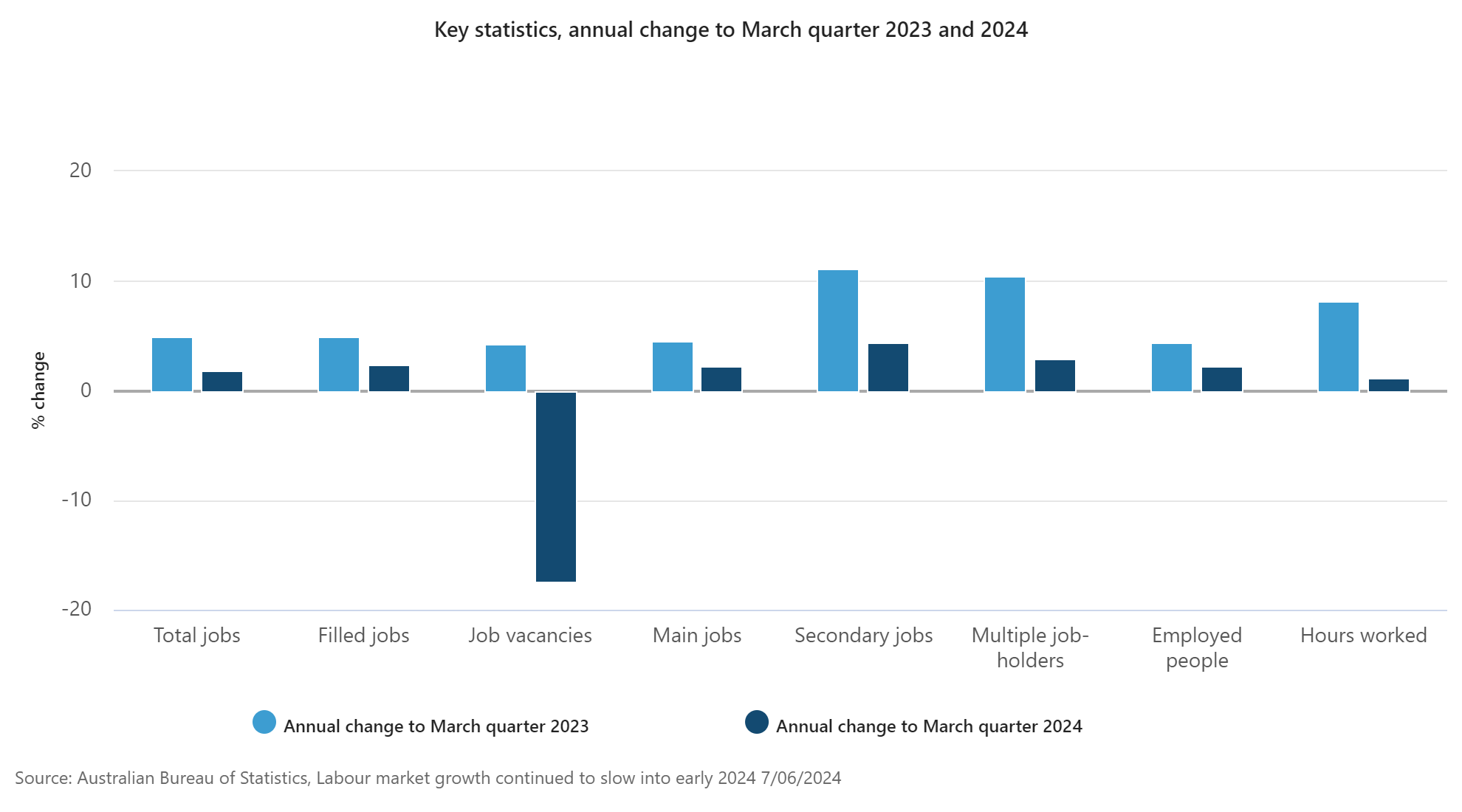Job vacancies down 4.3% in the March quarter

Filled jobs in Australia rose by 0.8% to 15.7 million in the March quarter of 2024, according to the latest quarterly Labour Account figures released by the Australian Bureau of Statistics (ABS).
Filled jobs increased by 124,000 in the March quarter, aligning with the average quarterly growth of 2023. Over the year, filled jobs grew by 2.4%, or 367,000, though this was about half the rate seen a year ago when the labour market was particularly tight.
Hours worked increased slightly by 0.1% this quarter after two consecutive declines in the latter half of 2023. Annually, hours worked rose by 1.1%, marking the slowest annual growth since March 2021, partly due to elevated hours worked in 2022-23.
“The slower growth in hours worked in the March quarter reflected a larger than usual number of people taking leave or waiting to start work over January, as well as continued weakness in industries that rely on discretionary consumer spending,” said Bjorn Jarvis (pictured), ABS head of labour statistics.
"Filled jobs rose by 124,000 in the March quarter 2024, which was broadly in line with the average quarterly growth seen across 2023," Bjorn Jarvis, ABS head of labour statistics
— Australian Bureau of Statistics (@ABSStats) June 7, 2024
Visit https://t.co/BhVbsxs9rx pic.twitter.com/E5XJjhoD5e
According to the latest figures, the number of multiple job holders rose by 12,000, or 1.2%, in the March quarter, aligning with the rise in people holding one job. Consequently, the multiple job-holding rate remained at 6.7%, slightly above the pre-pandemic range of 5.2 to 6%.
Job vacancies fell by 4.3% in the March quarter, dropping the proportion of total vacant jobs to 2.3%, the lowest since March 2021 but still above the 1.6% of March 2020.
“Despite a 25% drop from the peak in job vacancies seen in September 2022, there were still over 60% more vacant jobs than we saw before the pandemic,” Jarvis said. “There is still plenty of demand for workers, which is contributing to growth in employment.”

While labour market growth has slowed compared to a year ago, indicators still show growth rates at or above the long-term average.
Though the 2.4% annual increase in filled jobs was about half of the 4.9% seen a year ago, it was still above the 10-year pre-pandemic average of 1.7%.
Filled jobs grew in 13 out of 19 industries over the quarter, with the largest growth seen in health care and social assistance (+87,300), public administration and safety (+23,200), and education and training (+17,900). These gains were partially offset by declines in six industries, including a 2% drop in professional, scientific, and technical services (-25,700 jobs).
Hours worked rose in 10 out of 19 industries, with information media and telecommunications seeing the largest proportional growth at 4.7%, following an 11.5% drop in the previous quarter. Health care and social assistance also saw a significant rise in hours worked at 2.6%.
The largest declines in hours worked occurred in transport, postal and warehousing (-4.6%) and wholesale trade (-3.6%).
“Over the past five quarters, we’ve seen strong labour market growth in the three non-market sector industries – health care and social assistance, education and training, and public administration and safety – compared to the industries in the market sector,” Jarvis said.
“This suggests recent jobs and hours growth has been underpinned by activity around public services, rather than it being broad-based strength across the entire economy and labour market. The number of filled jobs in the health care and social assistance industry has risen by around 600,000 – that’s more than 30% in the past four years.”

Meanwhile, labour demand remained strong but softened over the March quarter, with job vacancies falling in 12 out of 19 industries. However, vacancies stayed above pre-pandemic levels in 17 out of 19 industries, with 11 industries reporting 50% or more vacancies than in March 2020.
The proportion of vacant jobs fell in 13 out of 19 industries since the last quarter. The largest declines were in mining and public administration and safety, both dropping to 4.6% and 2.2% of total jobs, respectively. The largest rise was in rental, hiring and real estate, increasing to 1.8%.
Want to be regularly updated with mortgage news and features? Get exclusive interviews, breaking news, and industry events in your inbox – subscribe to our FREE daily newsletter. You can also follow us on Facebook, X (formerly Twitter), and LinkedIn.



